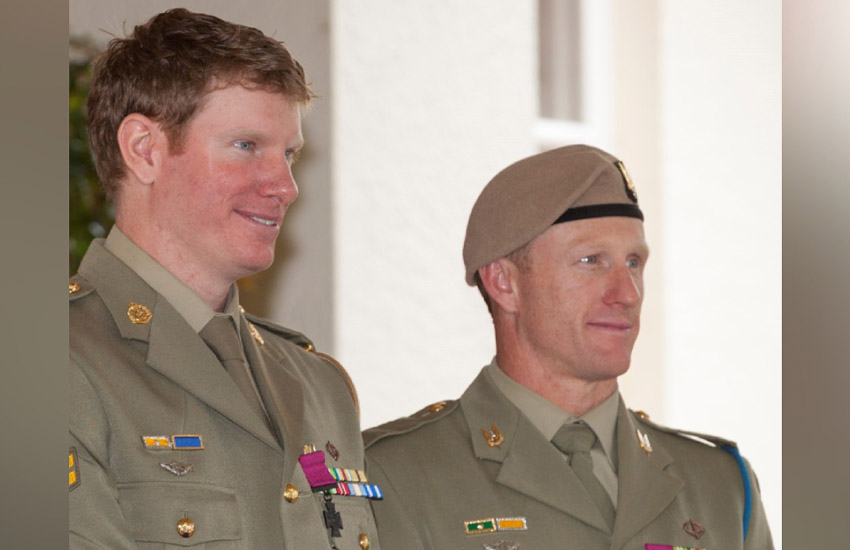Two Victoria Cross recipients outlined how cognitive decision-making tools and translation capabilities on battlefield radios could help Australia’s servicemen and women achieve their desired battlefield outcomes.

Daniel Keighran VC, key account manager - joint capability at Thales Australia and New Zealand and Mark Donaldson VC, strategic adviser for Microsoft.
At the recently held Land Forces 2022 International Land Defence Exposition in Brisbane, Momentum Media director Phil Tarrant was joined by strategic adviser for Microsoft Mark Donaldson VC and key account manager - joint capability at Thales Australia and New Zealand Daniel Keighran VC for a Defence Connect podcast episode.
The two Victoria Cross recipients discussed the importance of providing Australia’s servicemen and women with the latest equipment to help them succeed on the battlefield, including cognitive decision-making tools and translation capabilities.
The power of translation capabilities
Mr Donaldson said that through his role at Microsoft, he has been able to lift the “cognitive burden” away from defence personnel (including soldiers) as overloading them with information could sometimes create paralysis.
Technology could instead be utilised to containerised services and use it in a disconnected manner, Mr Donaldson explained.
For example, technology could enable translation or transcription capabilities with the use of voice-to-text or text-to-speech tools.
This could then be translated into different languages and transmitted onto different battlefield radios across other partner defence forces depending on the region the Australian defence force is operating in.
“They speak in their own native language, in their own native tongue and that comes back to you in English,” Mr Donaldson said.
“You can start to see the power of that when it comes to joint operations in particular, in our region.”
Enterprise resource planning for better use of assets
Alongside this, Mr Donaldson outlined the possibilities of enterprise resource planning (ERP), which is an integrated management of main business processes through a suite of integrated applications that an organisation can use to collect, store, manage, and interpret data from a range of business activities.
“The ability to take data off the vehicles and project forward those maintenance schedules and the things that are important that are going to need updating when I get back to a base [means that] the downtime of that vehicle is greatly reduced,” Mr Donaldson said.
“Therefore, that means that the soldiers are able to have use of their assets more often, and they're ready and they're available more often, which creates a better capability.”
Mr Donaldson suggested that tools currently used in the commercial world could potentially be transferred to the Australian defence force to improve efficiencies.
For example, NASA uses computer vision tools to identify wear and tear and determine whether any pieces of equipment require updating or maintenance, he observed.
“Again, if we take that idea and we put it into defence capability, you give a quick scan of a vehicle or weapon or whatever it is, and it’s able to identify without much human input into what needs servicing,” Mr Donaldson said.
“Again, you’re starting to speed up those cycles, [which means you’re left with] more time for training, more time doing the things that soldiers really need.”
Faster decision-making using tech
Microsoft and Thales Australia recently partnered with Australian small-to-medium enterprises (SME) Myriad Technologies, archTIS and Fortifyedge to launch Nexium Defence Cloud Edge (NDC Edge) — a secure tactical cloud computing capability at the edge of the battlespace.
Developed locally for the Australian Defence Force, NDC Edge platform facilitates the analysis and distribution of data in real time to streamline the decision-making process to “gain and maintain operational tempo”.
NDC Edge transfers capability from strategic headquarters to warfighters in the battlespace.
The technologies enable forces to operate autonomously in the theatre of operations, offering a range of possible configurations, from very high-capacity and easily scalable infrastructure to ‘all-in-one’ containerised systems.
Mr Keighran told the podcast that Thales’ NDC Edge demonstrator at Land Forces 2022 aimed to showcase decision-making at the edge.
He explained: “It’s a decision-making process whereby, for example, if you’ve got a capture device or some sort of camera, you’re running it through some cloud technology on the ground and you come across a high value target.
“It recognises that that individual in the system is a high-value target rather than having to push that information all the way back to headquarters. Individuals, or the soldiers on the ground all of a sudden have a picture in front of them whereby they can act on that intelligence right then and there.”
As well as addressing the unique interoperability challenges, the goal for Thales is to ensure that its NDC Edge sends information that is targeted and relevant to the warfighters to avoid burdening them with too much information, thereby boosting efficiency, Mr Keighran said.
“It’s about decision-making at the edge… as well as the agility and interoperability pieces,” he concluded.
To listen to the full podcast with Mark Donaldson VC and Daniel Keighran VC, click here:
Or alternatively you can click the player below: